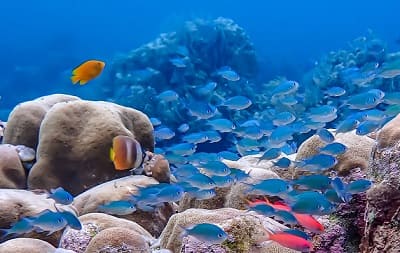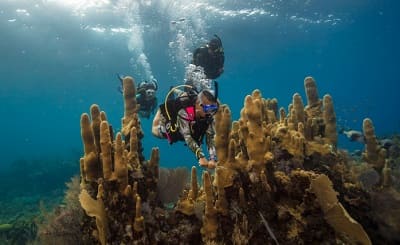Home › Sea Life Creatures › Marine Animals
A-Z Marine Life Animals
An encyclopedia of marine life animals is the ideal resource to learn more about how underwater creatures live and the importance of animal wildlife in the seas and oceans.
This section contains facts and information about marine animals, ocean fishes, aquatic mammals, and how marine science benefits benthic and pelagic saltwater ecosystems.
Underwater Animals that Live in the Oceans
To begin with, let's answer the question... What is marine life and what are some common examples of marine life animals?
A simple definition is any creature or organism living in the sea, ocean, or brackish water. Examples include:
- Aquatic mammals (e.g. dugong and manatee)
- Cephalopods, crustaceans, and shellfish
- Ocean fishes, sharks, rays, and sea turtles
The diversity of creatures that live in the seas and oceans is huge. It is a praiseworthy subject about marine biology and scientific research into coral reef systems, mangrove forests, and so much more.
So, the classification of marine animals in biology is the scientific study of organisms that live submerged in a body of salt water.
In a broad sense, aquatic marine life animals live in water with low salinity, or none whatsoever, such as lakes and freshwater river systems.
Nonetheless...
Some scientific research is commerce based. Many of the oceanic environments contain immeasurable supplies of minerals and chemicals. Some of which have commercial importance and medicinal benefits for the human race, such as for income, food, and tourism.
Pro Tip: It's easy to confuse the study of marine animals with marine ecology. Hence, studying specific organisms and sea animals in their habitats, their behavioural patterns, and how they interact with each other as well as their environment, is marine biology.
The Importance of Marine Life
Marine animals are important for several reasons. First, they play an important role in the earth's oxygen process (known as the oxygen cycle).
The climate, and the shorelines, are affected by the delicate interaction and behaviour between marine creatures and ocean plant life.
Thus, from microscopic zooplankton to gigantic whales (cetaceans), all sea life animals contribute to the continued existence of the planet as we know it today.
Here's the thing:
Not only do we explore marine life with scuba diving, we also get to interact with aquatic sea life, a variety of man made artificial reefs, and plants.
The oceans cover approximately seventy one percent (71%) of the surface of the planet. In addition to the marine creatures currently living beneath the surface, there are many more still waiting to be discovered - especially by PADI™ scuba divers.
Pro Tip: So, what does PADI stand for in diving? In short, the Professional Association of Diving Instructors helps to create a growing interest among environmental ambassadors to achieve various scuba diving certification levels and learn about snorkeling or other water-based activities.
Marine Organisms List
Some of the known and "extant" species that marine wildlife incorporates are found in the three categories of this marine animals list:
- Invertebrates: More than 98% of animal species on earth do not have a typical backbone (spinal cord).
- Vertebrates: The five groups that still exist today are amphibians, birds, fishes, reptiles, and mammals.
- Mammals include all warm-blooded vertebrates that have hair and feed milk to their young (includes human beings).
Invertebrate Sea Life
In its simplest form, the term "marine invertebrates" refers to all creatures that have no vertebral column and live in one of the marine habitats.
Instead, most species of invertebrate have either a robust chitinous exoskeleton, such as sea spiders, or a shell, like sea snails for example.
The group also contains a huge number of macroscopic organisms (visible to human eyes), such as worms, plankton and zooplankton.
But, the most common groups of invertebrate sea animals that scuba divers and snorkelers see underwater are:
Pro Tip: There are hundreds of examples of invertebrates in the section that contains facts and interesting information about the "spineless species".
Vertebrate Sea Animals
By and large, we can separate all marine vertebrates into two groups, marine fishes and marine tetrapods (extant and extinct).
In general, the tetrapod groups divide into three main categories of marine reptiles (e.g. turtles), marine mammals (e.g. whales), and sea birds (e.g. albatross, gulls, and penguins).
But, the common groups of vertebrate marine animals that scuba divers and snorkelers see underwater are:
- Anemonefish
- Angelfish
 Barracuda
Barracuda- Blennies
- Butterfly fish
- Cardinal fish
- Frogfish
- Gobies
- Moray eels
- Rays
- Sea bream
- Seahorses
- Sea snakes
- Sharks
- Turtles
- Weever fish
- Wrasses
Pro Tip: You will find more than 100 examples of vertebrate fish in the section that contains fun facts and interesting information about oceanic animals within the classification of "Kingdom Animalia" belonging to the subphylum "Vertebrata".
Marine Mammals
The four key taxonomic groups of aquatic mammals are those defined as having some reliance on a marine ecosystem for their survival.
Zoologists use several unique characteristics and traits to determine whether an animal is mammalian (of the breast) - or not!
The oceans, and a few freshwater systems, provide the essential habitats for about 130 different species of "true marine mammals".
We can divide them into the following taxonomic groups:
- Cetacea (e.g. dolphins, porpoises, and whales)
- Pinnipeds (e.g. seals and walruses)
- Sirenians (e.g. sea cows)
- Marine fissipeds (e.g. polar bears, sea otters)
Pro Tip: Check out a new section containing sea mammals examples from over 6,400 different vertebrate mammal species that are still in existence today.
Related Information and Help Guides
- Marine Biology Glossary of Terminologies
- Sea Life Animals Fun Facts and Information
- Underwater Vampires: Do they Really Exist?
- Weird Fish Names Chosen by Biologists
- Why are Plankton Important for Marine Life?
- Zooplankton Fun Facts and Information
Note: The video presented by "Scenic Scenes" contains amazing footage of how the marine life under the sea interacts with their environment - the Underwater World!
